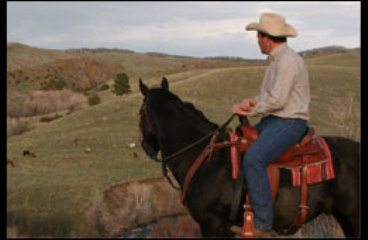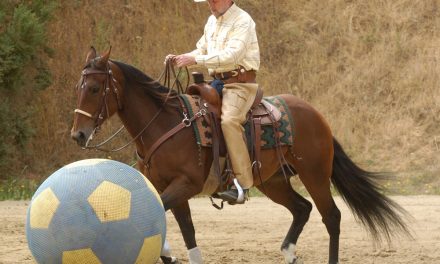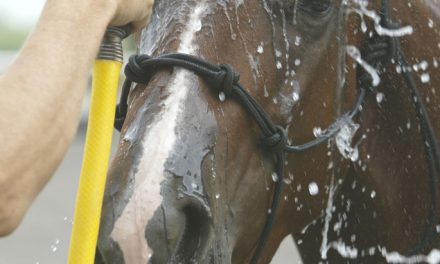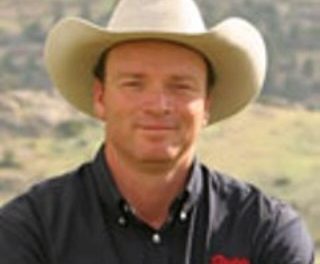 A spooky horse can be difficult to ride. You might feel you never know what will set off the next jump, and sometimes one horse spooking will set off the horses around him. It is easy for a spook to turn into a wreck. So, this month we will cover how to help your horse learn to control his emotions and have confidence in you as a rider and leader, even in unfamiliar or scary situations.
A spooky horse can be difficult to ride. You might feel you never know what will set off the next jump, and sometimes one horse spooking will set off the horses around him. It is easy for a spook to turn into a wreck. So, this month we will cover how to help your horse learn to control his emotions and have confidence in you as a rider and leader, even in unfamiliar or scary situations.
There are two reasons a horse will be spooky. One, the horse is young and inexperienced, and genuinely afraid of something. Two, the horse is older and experienced but has learned that spooking at things gets him a release from the work he is doing. The exercises we are going to cover will help in both situations. For these exercises, you will want to start in a round pen if you have access to one and then move out to an enclosed larger arena. You will need at least one person to help you, and some potentially scary objects: a lariat rope, a large ball, a tarp, foam water noodles, or a flag are some suggestions, but you can use whatever you have on hand. Your horse should be saddled and bridled, preferably with a snaffle bit.
Remember, with this exercise, as with everything you do around your horse, your safety and your horse’s safety are the top priority. Don’t try to push it and do something that gets you in a wreck. Take these exercises slowly and allow your horse to build his confidence and have success, as you build your confidence to ride him through situations where he is nervous.
Start without any spooky things in the round pen and work your horse in figure 8s and serpentines, focusing on softening his nose at each change of direction and keeping his feet moving forward. I like to work these exercises at the trot if possible. The goal here is to get your horse’s feet moving and his attention on you. Once you have this without distractions, have your friend come into the pen and start adding distractions. Your responsibility as a rider is to keep working with your horse on the same exercises as if nothing has changed. If you lose focus and start looking at the new, scary distractions, you can hardly blame your horse for doing the same! Have your helper start small, maybe by just jumping around a little and kicking some dirt. See how your horse handles this. If he spooks, have your friend just keep at it while you keep at your training exercises. If your horse does not spook when something new happens, pet him and let him know that was what you wanted. Keep adding more distractions and scarier things and you can move out to the larger arena once you are feeling confident.
You will never be able to expose your horse to every possible scary situation and thing he might encounter in his lifetime. So instead of trying to train for every specific thing you might come across, instead you are teaching your horse to control his emotions and look to you for guidance in any situation. Remember, the important thing is not how your horse responds to the scary object. The important thing is how he responds to you and your cues in the situation. Don’t get after your horse and start punishing him if he spooks, just keep working on your forward motion, changes of direction, and flexing. If you start punishing your horse every time he spooks, it just adds more anxiety to the situation as he anticipates the punishment, and that is not what you are after. However, don’t let the spook be a release. If your horse spooks, drive him right back up to the speed he was moving forward before the spook, or even a little faster. If he learns that spooking is a way to get the chance to stop and rest, your problem will just get worse.
Try to resist the urge to grab your horn for security when you think you are getting into a situation where your horse might spook. If you need to, grab the horn once he has spooked, but if you drop one rein and go for the horn before anything even happens, you take away your ability to guide your horse confidently with both reins. He needs your calm and clear direction most when you are coming up to something scary, and by taking that away you are sending him the wrong message about your leadership ability.
Most of the problems we have with our horses are caused by something we are doing or not doing in our training and riding. So remember to keep your attention on your training and your horse in all situations and in turn, he will learn to keep his attention on you and have confidence in you to guide him through anything.
Enjoy your horses and until next time, may God bless the trails you ride.
For more information on Ken McNabb’s programs call us at 307-645-3149 or go to www.kenmcnabb.com.





